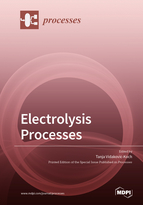Electrolysis Processes
A special issue of Processes (ISSN 2227-9717). This special issue belongs to the section "Chemical Processes and Systems".
Deadline for manuscript submissions: closed (30 November 2019) | Viewed by 125736
Special Issue Editor
Interests: dynamics of electrochemical systems; electrolysis; low temperature fuel cells; electroenzymatic processes; energy conversion in synthetic biology
Special Issue Information
Dear Colleagues,
Renewable energies such as solar, hydro or wind power are in principal abundant but subjected to strong fluctuations. Therefore, the development of new technologies for the storage of these renewable energies is of special interest. One scenario in energy storage is the chemical transformation of chemical compounds, such as water or carbon dioxide, into energy sources such as hydrogen or alcohols. Because of the rapid dynamics of electrochemical processes, it can be surmised that there will be an increased electrification of chemical processes for the use of excess current. In addition to the above-mentioned processes (water and CO2 electrolysis), the chemical industry, in the transition from fossil to renewable resources, requires new processes based on renewable raw materials. Here too, electrochemical and especially bio-electrochemical processes offer an attractive solution. This Special Issue of Processes invites contributions covering all electrochemical technologies supporting the transition from fossil to renewable energies and/or raw materials. Our special focus is on water and CO2 electrolysis. We encourage further contributions on novel electroenzymatic and microbial processes. Both experimental and modeling works providing new insights into the operation of electrochemical reactors under dynamic conditions, including aspects of catalyst and component aging (membranes, current collectors), as well as productivity and selectivity issues are highly welcome. The contributions can be regular papers, reviews or mini-reviews.
Dr. Tanja Vidakovic-Koch
Guest Editor
Manuscript Submission Information
Manuscripts should be submitted online at www.mdpi.com by registering and logging in to this website. Once you are registered, click here to go to the submission form. Manuscripts can be submitted until the deadline. All submissions that pass pre-check are peer-reviewed. Accepted papers will be published continuously in the journal (as soon as accepted) and will be listed together on the special issue website. Research articles, review articles as well as short communications are invited. For planned papers, a title and short abstract (about 100 words) can be sent to the Editorial Office for announcement on this website.
Submitted manuscripts should not have been published previously, nor be under consideration for publication elsewhere (except conference proceedings papers). All manuscripts are thoroughly refereed through a single-blind peer-review process. A guide for authors and other relevant information for submission of manuscripts is available on the Instructions for Authors page. Processes is an international peer-reviewed open access monthly journal published by MDPI.
Please visit the Instructions for Authors page before submitting a manuscript. The Article Processing Charge (APC) for publication in this open access journal is 2400 CHF (Swiss Francs). Submitted papers should be well formatted and use good English. Authors may use MDPI's English editing service prior to publication or during author revisions.
Keywords
- water electrolysis
- CO2 electrolysis
- electroenzymatic processes
- microbial processes
- dynamic operation
- catalyst aging
- selectivity and productivity






